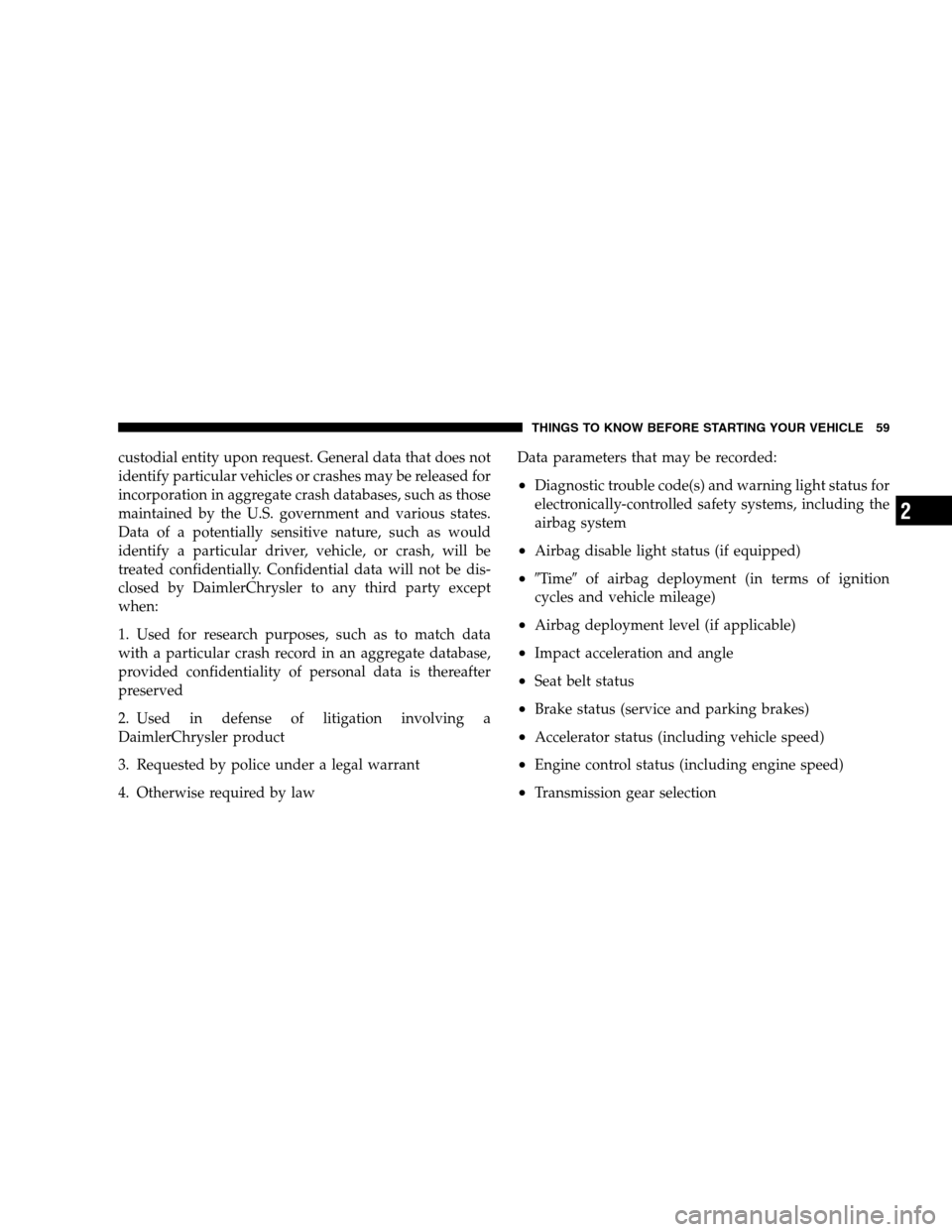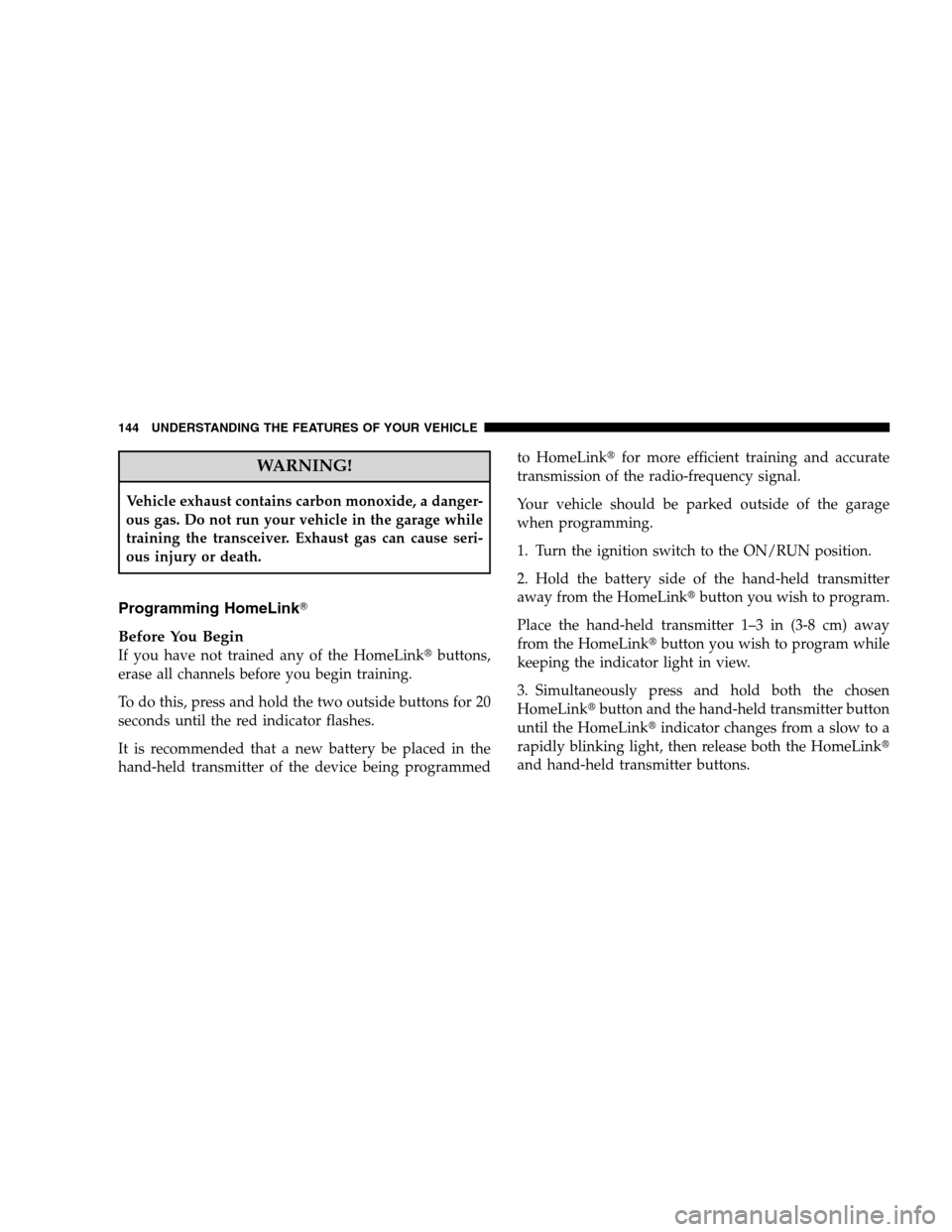Page 14 of 438
A WORD ABOUT YOUR KEYS
The authorized dealer that sold you your new vehicle has
the key code numbers for your vehicle locks. These
numbers can be used to order duplicate keys. Ask your
authorized dealer for these numbers and keep them in a
safe place.
Ignition Key Removal
Manual Transmission
1. Turn the ignition switch to the ACC position.
2. Push the key and cylinder inward and rotate the key to
the LOCK position.
3. Remove the key from the lock cylinder.
Vehicle Key
12 THINGS TO KNOW BEFORE STARTING YOUR VEHICLE
Page 15 of 438
Automatic Transmission — If Equipped
1. Place the shift lever in PARK.
2. Turn the ignition switch to the ACC position.3. Push the key and cylinder inward and rotate the key to
the LOCK position
4. remove the key from the lock cylinder.
Ignition Key Positions
Ignition Key Positions
THINGS TO KNOW BEFORE STARTING YOUR VEHICLE 13
2
Page 21 of 438
To Disarm The Security Alarm System
1. Press UNLOCK on the RKE transmitter.
2. Starting the vehicle with a valid Sentry Key�will
disarm the Security Alarm. A valid key is one that is
programmed to your vehicle. A valid key will disarm the
Security Alarm System; an invalid key will allow the
engine to run for two seconds and stop.
Security Alarm System Manual Override
The Security Alarm System will not arm if you lock the
doors using the manual door lock plunger.
REMOTE KEYLESS ENTRY (RKE)— IF EQUIPPED
This system allows you to lock or unlock the doors and
liftgate or activate the panic alarm from distances up to
66 ft (20 m) using a hand-held Remote Keyless Entry
(RKE) transmitter. The RKE transmitter does not need to
be pointed at the vehicle to activate the system.NOTE:The line of transmission must not be blocked
with metal objects.
Three Button RKE Transmitter
THINGS TO KNOW BEFORE STARTING YOUR VEHICLE 19
2
Page 29 of 438
CAUTION!
An unlocked vehicle is an invitation to thieves.
Always remove the key from the ignition and lock all
of the doors when leaving the vehicle unattended.
Power Door Locks
A power door lock switch is located on the drivers door
panel. Press this switch to lock or unlock the doors.
Automatic Door Locks — If Equipped
The doors will lock automatically on vehicles with power
door locks if all of the following conditions are met:
1. The Auto Lock feature is enabled.
2. The transmission is in gear.
Power Door Lock Switches
THINGS TO KNOW BEFORE STARTING YOUR VEHICLE 27
2
Page 31 of 438
Auto Unlock
The doors will unlock automatically on vehicles with
power door locks if:
1. The Auto Unlock feature is enabled.
2. The transmission was in gear and the vehicle speed
returned to 0 mph (0 km/h).
3. The transmission is in NEUTRAL or PARK.
4. The drivers door is opened.
5. The doors were not previously unlocked.
The Auto Unlock feature can be enabled or disabled.
Refer to “Personal Settings” under “Electronic Vehicle
Information Center (EVIC) — (if equipped)” in Section 4.
For vehicles not equipped with the EVIC, the Auto
Unlock Feature can be enabled or disabled by performing
the following procedure:1. Close all doors and place the key in the ignition.
2. Cycle the ignition switch between LOCK and ON and
back to LOCK four times, ending up in the LOCK
position.
3. Depress the power door UNLOCK switch to unlock
the doors.
Ignition Key Position
THINGS TO KNOW BEFORE STARTING YOUR VEHICLE 29
2
Page 61 of 438

custodial entity upon request. General data that does not
identify particular vehicles or crashes may be released for
incorporation in aggregate crash databases, such as those
maintained by the U.S. government and various states.
Data of a potentially sensitive nature, such as would
identify a particular driver, vehicle, or crash, will be
treated confidentially. Confidential data will not be dis-
closed by DaimlerChrysler to any third party except
when:
1. Used for research purposes, such as to match data
with a particular crash record in an aggregate database,
provided confidentiality of personal data is thereafter
preserved
2. Used in defense of litigation involving a
DaimlerChrysler product
3. Requested by police under a legal warrant
4. Otherwise required by lawData parameters that may be recorded:
•Diagnostic trouble code(s) and warning light status for
electronically-controlled safety systems, including the
airbag system
•Airbag disable light status (if equipped)
•�Ti m e�of airbag deployment (in terms of ignition
cycles and vehicle mileage)
•Airbag deployment level (if applicable)
•Impact acceleration and angle
•Seat belt status
•Brake status (service and parking brakes)
•Accelerator status (including vehicle speed)
•Engine control status (including engine speed)
•Transmission gear selection
THINGS TO KNOW BEFORE STARTING YOUR VEHICLE 59
2
Page 73 of 438
Periodic Safety Checks You Should Make Outside
The Vehicle
Tires
Examine tires for excessive tread wear or uneven wear
patterns. Check for stones, nails, glass, or other objects
lodged in the tread. Inspect tread and sidewall for cuts or
cracks. Check wheel nuts for tightness and tires (includ-
ing spare) for proper pressure.
Lights
Have someone observe the operation of exterior lights
while you work the controls. Check turn signal and high
beam indicator lights on the instrument panel.
Fluid Leaks
Check the area under the vehicle after overnight parking
for fuel, engine coolant, oil or other fluid leaks. Also, if
gasoline fumes are detected or fuel, power steering fluid,
transmission fluid or brake fluid leaks are suspected, the
cause should be located and corrected immediately.
THINGS TO KNOW BEFORE STARTING YOUR VEHICLE 71
2
Page 146 of 438

WARNING!
Vehicle exhaust contains carbon monoxide, a danger-
ous gas. Do not run your vehicle in the garage while
training the transceiver. Exhaust gas can cause seri-
ous injury or death.
Programming HomeLink�
Before You Begin
If you have not trained any of the HomeLink�buttons,
erase all channels before you begin training.
To do this, press and hold the two outside buttons for 20
seconds until the red indicator flashes.
It is recommended that a new battery be placed in the
hand-held transmitter of the device being programmedto HomeLink�for more efficient training and accurate
transmission of the radio-frequency signal.
Your vehicle should be parked outside of the garage
when programming.
1. Turn the ignition switch to the ON/RUN position.
2. Hold the battery side of the hand-held transmitter
away from the HomeLink�button you wish to program.
Place the hand-held transmitter 1–3 in (3-8 cm) away
from the HomeLink�button you wish to program while
keeping the indicator light in view.
3. Simultaneously press and hold both the chosen
HomeLink�button and the hand-held transmitter button
until the HomeLink�indicator changes from a slow to a
rapidly blinking light, then release both the HomeLink�
and hand-held transmitter buttons.
144 UNDERSTANDING THE FEATURES OF YOUR VEHICLE